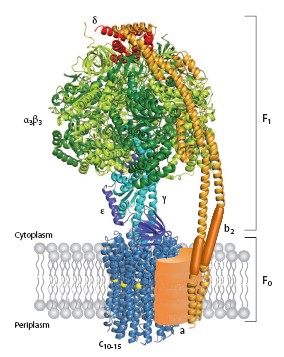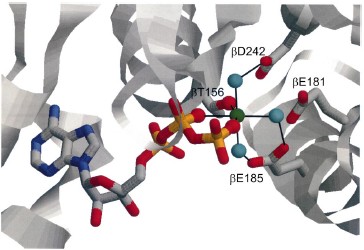Sandbox Reserved 494
From Proteopedia
| This Sandbox is Reserved from 13/03/2012, through 01/06/2012 for use in the course "Proteins and Molecular Mechanisms" taught by Robert B. Rose at the North Carolina State University, Raleigh, NC USA. This reservation includes Sandbox Reserved 451 through Sandbox Reserved 500. | |||||||
To get started:
More help: Help:Editing For more help, look at this link: http://www.proteopedia.org/wiki/index.php/Help:Getting_Started_in_Proteopedia
>
BackgroundATP synthesis is the most prevalent chemical reaction in the biological world and ATP synthase is one of the most ubiquitous, abuntant proteins on earth. From Escherichia coli to plants and mammals, this enzyme is one of the most conserved during evolution[1]. PDB code of ATP synthase is 1c17. The molecular study of ATP synthase was initiated in 1960 when Efraim Racker and his colleagues reported the isolation of soluable factor from beef heart mitochondria. ATP synthase produces ATP from adenosine diphosphate (ADP) and inorganic phosphate with the use of energy from a transmembrane proton-motive force generated by respiration or photosynthase[2]. Structure of ATP synthaseStrucutre of ATP synthases are basically similiar whatever the source. In their simplest form in prokaryotes, they contain eight different subunits, with stoichiometry αβ3γδεab2c10-15. The total molecular size is about 530kDa[3]. The enzyme consists of the extramembranous F1 catalytic domain linked by means of a central stalk to an intrinsic membrane domain called F0. In the atomic structure of F1, the α and β subunits are arranged alternately around a coiled coil of two antiparallel α helices in the γ subunit [4]. ATP synthase has many and . The catalytic sites are in the β subunits at the α/β subunit interface. The remainder of the γ subunit protrudes from the α3β3 assembly and can be cross linked to the polar loop region of the c subunits in F0. In mitochondria, the δ and ε subunits are associated with the γ subunit in the central stalk assembly, as are the bacterial and chloroplast ε subunits, the counterparts of mitochondrial δ. ATP-dependent rotation of γ and ε within an immobilized α3β3 complex from the thermophilic bacterium Bacillus PS3 has been observed directly.  Two structural domains of ATP synthase[4]. High resolution structure analysisThe first atomic-level (2.8Å) resolution structures by X-ray, strucutures was of bovine mitochondrial F1 in 1994. The α and β subunits each had similiar three-domain structure, with an N-terminal β-barrel furthest away from the membrane surface, a central nucleotide-binding domain, and a C-terminal helical domain. Also, an NMR structure of isolated E. coli ε subunit is in good agreement with X-ray structure. The structure of the N-terminal domain of E. coli δ subunit consisting of residues 1 through 134 was solved also by NMR [3]. In addition, according to analyses by SDS-polyacrylamide gel electrophoresis (SDS-PAGE) , high-performance liquid chromatography (HPLC) analysis, and NH2-terminal sequencing, the purified complex used here for crystallization consists of subunis α, β, γ, δ, ε, b, d, a, h, f, ATP8, and c (in diminishing apparent molecular weight order for F1 and F0 on SDS gels) is similar to other preparations. Reaction analysis of the catalytic sitesThe energy for ATP synthesis is provided from proton transport along the gradient of electrochemical potential of protons across membranes (△H). When the magnitude of △H is large, as in functional mitochondrial, downhill proton flow through F0 causes rotation of the F0 rotor and hence rotation of the γε-subunits of F1. The rotary motion of the γ alternates the structure of the β-subunit so the ATP is synthesized[5]. Mutagenesis of catalyticsites of ATP synthase have proceeded extensively in the E. coli enzymes, somewhat less so in Saccharomyces cerevisiae and Bacillus PS3, and to far lesser extent in other species. Almost without exception, detailed in vitro biochemical analyses of purified mutant enzymes have been limited to the ATP hydrolysis reaction. However, in both yeast and E. coli, growth tests on nonfermentable substrates provide sensitive if quantative assays of ATP synthesis in the cell. Ligands to the Mg2+ cation have been studied in detail by mutagenesis and functional analysis [6].  Octahedral coordination of Mg2+ in the catalytic site of ATP synthase[3]. PerspectiveAs a motor protein, ATP synthase offers a rare research opportunity. Structure of the F1 motor, both rotor and stator in the same assembly, are known in atomic detail for the first time, and rotation can be analyzed at sub-millisecond time resolution [7]. An emerging possibility of step-size mismatch between the F1 and F0 motors provides an opportunity to find a noval coupling mechanism of the two motors that will explain why the mismatch is good for the enzyme. Finally, one can even dream of using this, the world's tiniest motor, as an engine part in the fabrication of nano-machines. The marvel of ATP will continue[1]. Additional ResourcesFor additional information, see: Photosynthesis
References
--Hao Lu |
